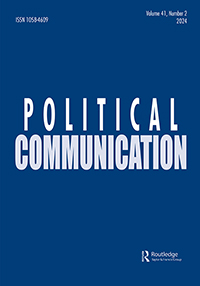Strategies of Chinese State Media on Twitter
IF 5.1
1区 社会学
Q1 COMMUNICATION
引用次数: 0
Abstract
How do state-controlled broadcasters reach foreign publics to engage in public diplomacy in the era of social media? Previous research suggests that features unique to social media, such as the ability to engage in two-way communication with audiences, provide state-controlled broadcasters new opportunities for online public diplo-macy. In this paper, we examine what strategies were used by four Chinese state-controlled media outlets on Twitter to reach foreign publics as the Chinese Communist Party worked to expand its public diplomacy and international media outreach e ff orts. We fi nd that all outlets increased the volume and diversity of content while none engaged in interactive, two-way communication with audiences, and none appeared to arti fi cially in fl ate their follower count. One outlet, China Global Television Network, made outsized gains in followership, and it di ff ers from the other Chinese outlets in that it was rebranded, it disseminated a relatively lower share of government-mandated narratives pertaining to China, and the tone of its reporting was more negative. These results show that during a period when Chinese state-controlled broadcasters gained followers on Twitter, outlets made limited use of features unique to social media and instead primarily used social media as a broadcast channel.中国官方媒体在Twitter上的策略
在社交媒体时代,国家控制的广播公司如何接触外国公众参与公共外交?先前的研究表明,社交媒体特有的功能,如与观众进行双向沟通的能力,为国家控制的广播公司提供了在线公共外交的新机会。在这篇论文中,我们研究了四家中国国有媒体在推特上使用了什么策略来接触外国公众,因为中国共产党正在努力扩大其公共外交和国际媒体外联活动。我们发现,所有媒体都增加了内容的数量和多样性,而没有一家媒体与观众进行互动、双向交流,也没有一家似乎在提高其追随者数量。中国环球电视网(China Global Television Network)是一家收视率极高的电视台,它与其他中国电视台的不同之处在于,它被重新命名,传播的政府授权的与中国有关的叙事比例相对较低,报道的基调更为负面。这些结果表明,在中国国家控制的广播公司在推特上获得粉丝的时期,媒体有限地使用社交媒体特有的功能,而主要将社交媒体作为广播渠道。
本文章由计算机程序翻译,如有差异,请以英文原文为准。
求助全文
约1分钟内获得全文
求助全文
来源期刊

Political Communication
Multiple-
CiteScore
13.90
自引率
2.70%
发文量
30
期刊介绍:
Political Communication is a quarterly international journal showcasing state-of-the-art, theory-driven empirical research at the nexus of politics and communication. Its broad scope addresses swiftly evolving dynamics and urgent policy considerations globally. The journal embraces diverse research methodologies and analytical perspectives aimed at advancing comprehension of political communication practices, processes, content, effects, and policy implications. Regular symposium issues delve deeply into key thematic areas.
 求助内容:
求助内容: 应助结果提醒方式:
应助结果提醒方式:


